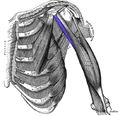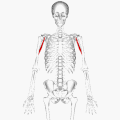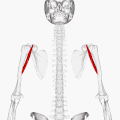Coracobrachialis muscle
Coracobrachialis muscle is a small, cylindrical muscle located in the upper arm. It plays a crucial role in the movement and stabilization of the shoulder joint. The muscle originates from the coracoid process of the scapula and inserts into the medial surface of the humerus shaft. It is innervated by the musculocutaneous nerve and receives its blood supply from the brachial artery.
Anatomy[edit]
The coracobrachialis muscle is one of the three muscles that make up the anterior compartment of the arm, along with the biceps brachii and brachialis muscles. It extends from the coracoid process of the scapula to the middle third of the medial surface of the humerus. This muscle is situated deep to the biceps brachii and is partially covered by the pectoralis major at its origin.
Origin and Insertion[edit]
The coracobrachialis originates from the tip of the coracoid process of the scapula. It inserts into the medial surface of the humerus, specifically at the rough area of the middle third of the bone. This positioning allows the muscle to exert its effects on the shoulder joint.
Innervation[edit]
The coracobrachialis is innervated by the musculocutaneous nerve, a branch of the brachial plexus. The nerve enters the muscle on its medial side, providing the necessary stimuli for muscle contraction.
Blood Supply[edit]
Blood supply to the coracobrachialis is primarily through the brachial artery. Smaller branches from the artery penetrate the muscle to deliver oxygenated blood and nutrients.
Function[edit]
The primary function of the coracobrachialis is to assist in flexing and adducting the arm at the shoulder joint. It acts synergistically with other muscles of the shoulder to stabilize the joint, especially during movements of the arm. The coracobrachialis also helps in preventing dislocation of the shoulder by holding the head of the humerus in the glenoid cavity of the scapula.
Clinical Significance[edit]
Injury to the coracobrachialis or its nerve supply can result in weakness or loss of function in flexing and adducting the arm. Such injuries may occur due to trauma, repetitive use, or as a result of surgical procedures in the vicinity of the muscle or its nerve supply.
Exercises[edit]
Strengthening and stretching exercises targeting the coracobrachialis can improve the muscle's function and reduce the risk of injury. Examples include resistance band exercises and specific stretches that target the anterior shoulder compartment.
See Also[edit]
-
Coracobrachialis muscle
-
Coracobrachialis muscle
-
Coracobrachialis muscle
-
Coracobrachialis muscle
-
Coracobrachialis muscle
-
Coracobrachialis muscle
-
Coracobrachialis muscle
-
Coracobrachialis muscle
-
Coracobrachialis muscle
-
Coracobrachialis muscle
-
Coracobrachialis muscle
Ad. Transform your life with W8MD's Budget GLP-1 injections from $75


W8MD offers a medical weight loss program to lose weight in Philadelphia. Our physician-supervised medical weight loss provides:
- Weight loss injections in NYC (generic and brand names):
- Zepbound / Mounjaro, Wegovy / Ozempic, Saxenda
- Most insurances accepted or discounted self-pay rates. We will obtain insurance prior authorizations if needed.
- Generic GLP1 weight loss injections from $75 for the starting dose.
- Also offer prescription weight loss medications including Phentermine, Qsymia, Diethylpropion, Contrave etc.
NYC weight loss doctor appointmentsNYC weight loss doctor appointments
Start your NYC weight loss journey today at our NYC medical weight loss and Philadelphia medical weight loss clinics.
- Call 718-946-5500 to lose weight in NYC or for medical weight loss in Philadelphia 215-676-2334.
- Tags:NYC medical weight loss, Philadelphia lose weight Zepbound NYC, Budget GLP1 weight loss injections, Wegovy Philadelphia, Wegovy NYC, Philadelphia medical weight loss, Brookly weight loss and Wegovy NYC
|
WikiMD's Wellness Encyclopedia |
| Let Food Be Thy Medicine Medicine Thy Food - Hippocrates |
Medical Disclaimer: WikiMD is not a substitute for professional medical advice. The information on WikiMD is provided as an information resource only, may be incorrect, outdated or misleading, and is not to be used or relied on for any diagnostic or treatment purposes. Please consult your health care provider before making any healthcare decisions or for guidance about a specific medical condition. WikiMD expressly disclaims responsibility, and shall have no liability, for any damages, loss, injury, or liability whatsoever suffered as a result of your reliance on the information contained in this site. By visiting this site you agree to the foregoing terms and conditions, which may from time to time be changed or supplemented by WikiMD. If you do not agree to the foregoing terms and conditions, you should not enter or use this site. See full disclaimer.
Credits:Most images are courtesy of Wikimedia commons, and templates, categories Wikipedia, licensed under CC BY SA or similar.
Translate this page: - East Asian
中文,
日本,
한국어,
South Asian
हिन्दी,
தமிழ்,
తెలుగు,
Urdu,
ಕನ್ನಡ,
Southeast Asian
Indonesian,
Vietnamese,
Thai,
မြန်မာဘာသာ,
বাংলা
European
español,
Deutsch,
français,
Greek,
português do Brasil,
polski,
română,
русский,
Nederlands,
norsk,
svenska,
suomi,
Italian
Middle Eastern & African
عربى,
Turkish,
Persian,
Hebrew,
Afrikaans,
isiZulu,
Kiswahili,
Other
Bulgarian,
Hungarian,
Czech,
Swedish,
മലയാളം,
मराठी,
ਪੰਜਾਬੀ,
ગુજરાતી,
Portuguese,
Ukrainian










